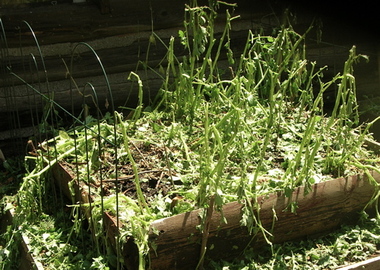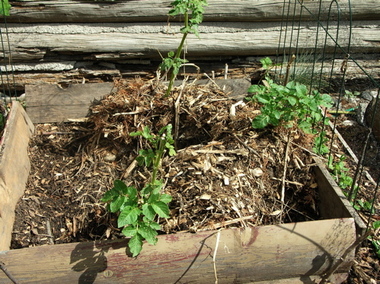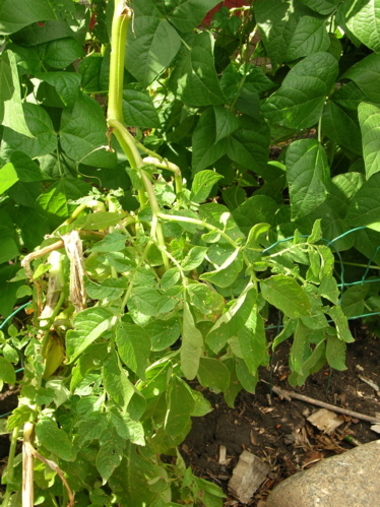UPDATED Note, 9/21/08: In the original post, I was unable to link to Dee’s blog Red Dirt Ramblings, because of some problem with a server. I’ve added the link as of today, but it may be unstable.
Those of you with exceptional memories and nothing to do may recall the hailstorm that hit Bozeman six weeks ago, devastating my garden and stripping my potatoes. In the depths of my initial misery, I threw myself on the ample bosom of the blogosphere, asking whether to leave these or yank what was left. My question got mixed responses, including the awful suggestion from Dee of Red Dirt Ramblings, who pointed out that even if these stems sprouted new leaves, they might do so by drawing on the tubers.
This was such a dreadful possibility that I rushed outside forthwith, garden fork in hand. Faced with those decimated stems, I found myself unable to proceed, but somehow newly empowered to face the Internet. So I put down the fork and picked up the computer.
As I reported in a response to comments to the original post, “Potatoes, hail, damage,” did the trick, and within fifteen minutes it appeared I was set. (Did you know that researchers have actually simulated hail damage to potatoes in order to learn how foliage damage affects tuber growth? Neither did I.)
There were actually several relevant studies, some on fields affected by real hail, some the victims of simulated hail. None of these studies suggested pulling damaged potatoes. I was not just relieved, I was practically gloating. (So, Dee, you were wrong. Got that? Wrong, wrong, wrong, and thank goodness.)
What I found was a surprise as well as a reprise: it appeared that one should leave potato plants damaged by hail or other physical forces such as wind, a kid on a tricycle, a fallen fence, a wandering goat. Disease is different, of course.
According to my sources, (ahem) tuber yield depends on both the extent and the timing of the damage. Obviously, the less foliage damaged, the better. What surprised me, though, was that these studies all showed that younger plants recover more completely than older ones. On reflection that makes sense, but at the time I was reasoning that a more mature plant would have created more tubers already and would be better able to finish the job it had started than an immature plant.
The critical dividing line is flowering, and the critical extent is 50 percent. If damage is inflicted before potatoes flower and takes out 25% or less of the foliage, there’s almost no decrease in yield. Damage inflicted after flowering, or destroying more than 50% of the foliage, seriously decreases yield.
So what does this mean for me and my potatoes?
The first ones I planted this year went into the ground next door, where five young guys have granted me gardening privileges.
The second batch, maybe two weeks later, went into one of my own little plots on the alley behind my garage, open to the west. The storm (sorry: storms, since one waltzed in at about two p.m. and one roared through six or seven hours later) came in from the west, so these plants, which were just about to flower, took the brunt, and by the time the second had passed, they looked like this:
In other words, they sustained almost 100% damage.
However, a few leaves were left on each stalk, and encouraged by my research, I left them. Within a few days it was clear that several weren’t going to make it, and after a couple of weeks I had pulled or dug up five of the original eight. Here’s what the plot looked like on September 6th, the day before I flew to Newfoundland:
Just next door, a tall fence bounds the west side of the yard—and the garden. The potatoes, planted within several feet of that fence, had already started flowering. But, protected by the fence, they sustained only 25% to 50% damage. (These are professional estimates, of course.) On the 6th, those plants looked like this:
The potato, obviously, is the plant in front of those luxurious, darker beans. Despite the stems broken by hail, these potatoes are in much better shape than the younger ones on the alley, which bore the full brunt of the storm. Youth, in other words, was not enough to save those plants.
I love new potatoes, but I’ve forgone them this year, because the yield is going to be so small anyway. All right, I did dig a few, and I’ve actually checked for newbies a couple of times, but the results have not been encouraging. So it’s a matter of waiting to see what these actually produce.
* * * * * * * * *
On August 16, almost a month after "my" storm, a major hailstorm hit San Luis Valley in Colorado, doing millions of dollars in damage. Me, I lost five plants. That contrast helps me keep a sense of perspective.
The article set me back on my heels in more than one way, though, because it appeared to suggest that Dee might have been right after all….




 Subscribe to RSS feed
Subscribe to RSS feed



Yes, my blog has been down all week. The server is ill. I’m at the GWA symposium in Portland, so I’ll deal with changing servers next week.
I went back and looked at my comment. I still think I’m not “wrong, wrong wrong,” but it was just an opinion. The potato is the starch which fuels the leaves which is where I was coming from, so I still defend my idea, even if it works to leave them in the ground. I never said they would rot. I was just thinking they would be smaller potatoes, and that I would like to eat them. I’m glad to hear that you found your answer.~~Dee
I wish I had found my answer, Dee, but as my next post explains, there’s more than one version out there, and the next one I saw is a lot closer to your position than to the one I was so happy to find. Serves me right–
I meant to hint here that I was a bit too eager to dismiss your idea, but apparently the hint was too obscure. Sorry. I’d be more than happy to share the potatoes–if there are any!
Good luck with your server, when you return home.
–Kate